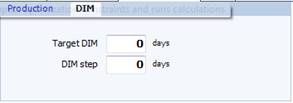
An alternative feature, available in a second tab labelled DIM, provides a step feeding schema based on days in milk ranges:

In this case, the information needed are the Target DIM and the number of days for each range (DIM step). Once these data are entered in the related text boxes, it is possible to start the process clicking on the Proceed button.
The procedure populates a grid, with the first column showing the days in milk ranges. The second column contains the Total DMI for each step. Total DMI is estimated by standard curves, which are adjusted according current DMI. The amounts for the step feeding feeds are not calculated, and the Base DMI column values are just set to the related Total DMI predicted.

You can start now entering the desired amounts for the step feeds. The Total DMI is recalculated according to the values assigned to the Base DMI and the other feeds, and the model parameters are updated each time a value is entered.
This approach might be of interest for the herds working with robotic milking. On farms that use robotic milker (AMS), the total mixed ration gives way to a partial mixed ration (PMR). The PMR is offered at the feed bunk, while the rest of the concentrate goes to the cows when they are in the robotic milking box. One of the challenges facing nutritionists is balancing the nutrients in the PMR and in the feed/s offered in the milking box. Having to work with that combination of PMR and feed/s at the robot, it makes feeding management one of the major factors for success with automatic milking systems, given that feed offered in the AMS unit is the major motivating factor to attract cows consistently to visit the milking station.
There are complicated interactions among cow behavior, activity, the ration fed, feed consumption, health and milk production, so a poor-performing AMS can cause problems and frustration for both farmers and nutritionists.
In order to handle properly these nutritional interactions, feeding a well-balanced diet, the days in milk step feeding approach can be an alternative to the production step feeding, mainly at early lactation. It leaves more freedom to the nutritionist to determine the strategy for supplying the feed in the milking box that he considers most appropriate in each specific herd condition, always providing guidelines in order to obtain a balanced and healthy diet.
Primiparous vs. Mature cow
Another aspect that could be considered is related to the definition of different strategies for feeding grain between primiparous and mature cows.
The total DMI by days in milk is predicted by NDS Milk Step Feeding tool through standard DMI curves, adjusted according the current DMI for the feeding group.

Since the DMI curves patterns are different between first calves and mature cow, it might be difficult to set a single step feeding report, able to working fine for both types of animals. For this reason, we suggest to define different recipes, each one based on the current intake for the group considered (primiparous vs. multiparous), then to run separate step feeding reports for the specific group of animals. This may help to define the most appropriate amount of grain being fed by balancing these amounts with a realistic intake of basal diet (PMR).